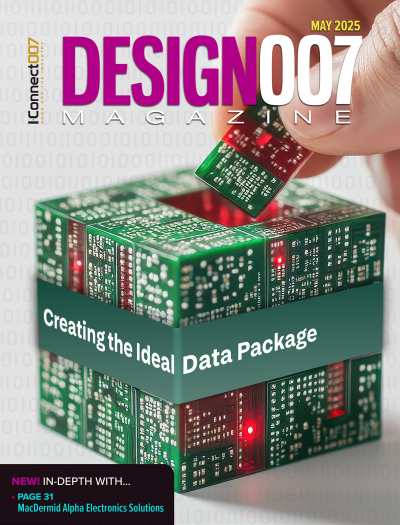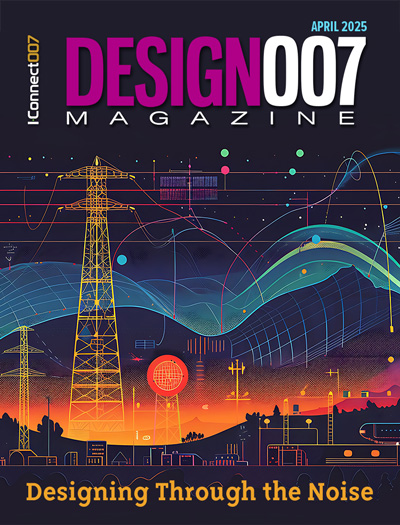-

- News
- Books
Featured Books
- design007 Magazine
Latest Issues
Current Issue
All About That Route
Most designers favor manual routing, but today's interactive autorouters may be changing designers' minds by allowing users more direct control. In this issue, our expert contributors discuss a variety of manual and autorouting strategies.

Creating the Ideal Data Package
Why is it so difficult to create the ideal data package? Many of these simple errors can be alleviated by paying attention to detail—and knowing what issues to look out for. So, this month, our experts weigh in on the best practices for creating the ideal design data package for your design.

Designing Through the Noise
Our experts discuss the constantly evolving world of RF design, including the many tradeoffs, material considerations, and design tips and techniques that designers and design engineers need to know to succeed in this high-frequency realm.
- Articles
- Columns
Search Console
- Links
- Media kit
||| MENU - design007 Magazine
BGA Fanout Routing Overview
September 4, 2018 | Christian Keller, AltiumEstimated reading time: 1 minute
PCB developers are deluged with new challenges caused by increasing density and smaller components. Ball grid arrays (BGAs) create particular challenges during layout, with hundreds of connections in just a few square centimeters. Fortunately, designers now have options for addressing these issues.
Fanout and Escape Routing
Because of the density and distance from the connection points, only the two outermost rows of a BGA can be connected directly to surface circuit traces. All other terminals of the BGA cannot be connected in a direct path on the surface.
Fanout and escape routing is integrated in many PCB design systems to enable further connections. In fanout and escape routing, the two outermost rows, and all other rows of a BGA, are automatically connected to the center of the terminals via a short circuit trace that is executed at a 45° angle. This provides a blind via that forms a direct connection to the next signal layer. Routing can be executed on the next signal layer.
Using via-in-pad eliminates the need for the additional trace to the center of the connections, thereby creating additional space for circuit traces. Therefore, with via-in-pad, the through contact can be placed directly at the terminal of the BGA.
During circuit board manufacturing, these through contacts will be filled with a non-conducting medium and cured. Later, the ends are metallized, planarized, and also over-contacted. This makes the surface of the via flat and can be used the contacts of the BGA. This solution can be used for both stacked and staggered microvias and/or blind vias. IPC-4761 describes how via-in-pads, for example filled and capped vias (IPC-4761 Type VII), are prepared. Despite the higher manufacturing costs, via in pads will always be preferred, because of the higher integration density of BGAs and their lower inductance at high frequencies (signal quality).
To read this entire article, which appeared in the August 2018 issue of Design007 Magazine, click here.
Suggested Items
IPC Rebrands as Global Electronics Association: Interview With Dr. John W. Mitchell
06/22/2025 | Marcy LaRont, I-Connect007Today, following a major announcement, IPC is embracing the rapid advancement of technology with a bold decision to change its name to the Global Electronics Association. This name more accurately reflects the full breadth of its work and the modern realities of electronics manufacturing. In this exclusive interview, IPC President and CEO Dr. John W. Mitchell shares the story behind the rebrand: Why now, what it means for the industry, and how it aligns with the organization’s mission.
Global Electronics Association Debuts; New Name Elevates IPC’s 70-Year Legacy as Voice of $6 Trillion Electronics Industry
06/22/2025 | Global Electronics AssociationToday begins a new chapter for IPC as it officially becomes the Global Electronics Association, reflecting its role as the voice of the electronics industry. Guided by the vision of “Better electronics for a better world,” the Global Electronics Association (electronics.org) is dedicated to enhancing supply chain resilience and promoting accelerated growth through engagement with more than 3,000 member companies, thousands of partners, and dozens of governments across the globe.
I-Connect007 Editor’s Choice: Five Must-Reads for the Week
06/20/2025 | Andy Shaughnessy, I-Connect007It’s been a busy week in this industry, and we have news and articles from the PCB design, fabrication and assembly communities. Some of this news is out of this world. We may be losing the high ground—the really high ground. Columnist Jesse Vaughan explains how the U.S. seems to be falling behind in space, and how this could affect our ability to defend ourselves in the future. We have an update on the U.S.-China tariff talks, which seem to be moving forward, though sometimes at a snail’s pace.
New IPC VP Joe Schneider Building Stronger Focus on U.S., Canada
06/19/2025 | Marcy LaRont, I-Connect007IPC has hired Joe Schneider as a vice president to strengthen its regional focus and address the specific needs in the U.S. and Canada. Joe brings a rich background in OEM and contract manufacturing, including with industry giants like Siemens and Abbott Laboratories. In this interview, he shares his vision for the region, which emphasizes workforce development and supply chain challenges.
IPC Update on the Latest U.S.– China Trade Announcement
06/18/2025 | IPCOn June 12, the Trump Administration announced an agreement to implement the framework of the trade deal with China reached earlier in May. Reports indicate the following high-level terms: A 55% combined tariff on imports from China, 10% “reciprocal” tariffs under the International Emergency Economic Powers Act (IEEPA), 20% IEEPA-based fentanyl tariffs, and Existing Section 301 tariffs, which in many cases are 25%.


